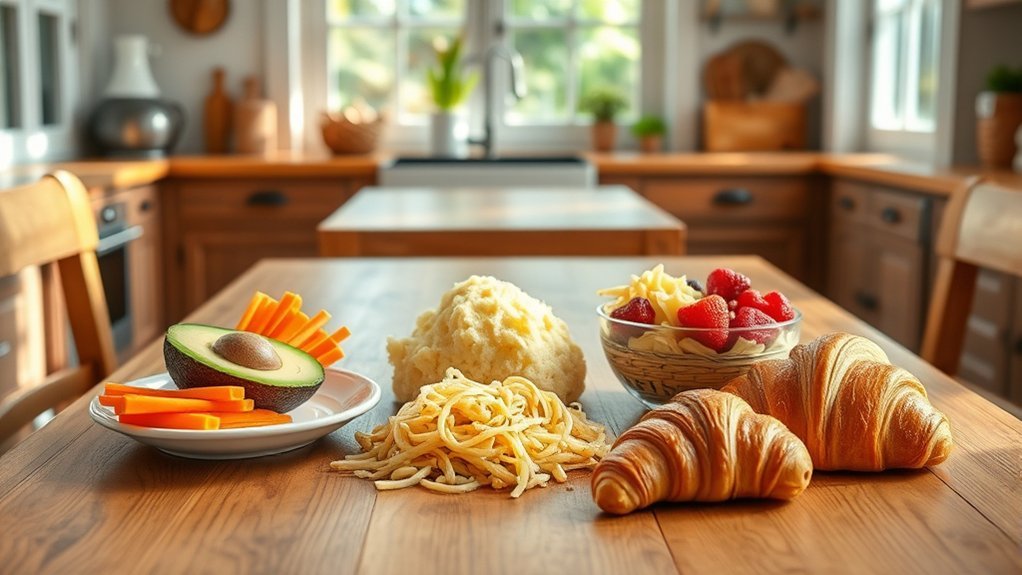Understanding food textures is essential for shaping your child’s eating habits. The way a food feels can greatly influence their willingness to try new items. By recognizing the impact of textures like crunchy, creamy, and chewy, you can strategically introduce variety into their meals. However, simply offering different textures isn’t enough; the approach you take matters. How can you effectively navigate this complex landscape to foster better eating habits?
The Role of Texture in Children’s Food Preferences
When it comes to children’s food preferences, texture plays an essential role that often goes overlooked. You might notice your child gravitating toward certain foods while rejecting others, and texture is often the key factor. Children tend to prefer foods that offer familiar and appealing textures, like crunchy vegetables and creamy yogurts. Conversely, they may avoid foods with unfamiliar or unpleasant textures, such as slimy or gritty items. Understanding this can help you make more informed choices when introducing new foods. By incorporating a variety of textures, you can enhance your child’s overall eating experience. Experimenting with different preparations—like roasting, steaming, or pureeing—can also help you find the textures your child enjoys most, making mealtime more enjoyable for everyone involved.
How Texture Affects Acceptance of New Foods
Texture greatly influences a child’s willingness to try new foods. Children often develop preferences based on the tactile sensations they experience while eating. For instance, smooth, creamy textures can be more appealing than chunky or gritty ones, especially for younger kids. When introducing new foods, you should consider how their texture aligns with your child’s existing favorites. If they enjoy crunchy snacks, try introducing similar textures in new foods, such as roasted vegetables or whole-grain crackers. Conversely, avoid introducing new foods with unfamiliar textures that could lead to rejection. By strategically presenting foods with familiar textures, you can gradually expand your child’s palate, fostering greater acceptance of diverse foods and enhancing their overall nutrition.
Exploring Different Food Textures
While many parents focus on flavors, exploring different food textures can greatly enhance a child’s eating experience. Textures play an essential role in how children perceive and enjoy food. Crunchy, creamy, chewy, and smooth textures can evoke different sensory responses, which may influence their willingness to try new foods. For instance, a crunchy carrot might be more appealing than a mushy one, as the crunchiness can provide a satisfying sensation. Additionally, introducing a variety of textures helps develop their oral motor skills, vital for their overall development. Pay attention to how your child reacts to various textures, as this awareness can guide you in creating balanced meals that cater to their preferences while encouraging exploration and acceptance of diverse foods.
Strategies for Introducing Variety in Textures
Introducing a variety of textures into your child’s meals can greatly enhance their eating habits and willingness to explore new foods. Start by gradually incorporating new textures alongside familiar ones. For instance, mix crunchy vegetables with smooth dips to create a contrast that intrigues your child. Experiment with cooking methods—steaming, roasting, or blending—to achieve different textures. You can also create layered dishes, like parfaits with yogurt, fruit, and granola, to showcase various textures. Encourage your child to participate in food preparation; letting them touch and feel ingredients can spark curiosity. Additionally, maintain a positive attitude towards new textures, as your enthusiasm can influence their willingness to try these foods. Consistency and creativity are key to fostering a diverse palate.
Encouraging Positive Eating Habits Through Texture
When you focus on the diverse textures of foods, you can significantly influence your child’s eating habits and attitudes toward trying new things. Different textures can make meals more appealing and encourage exploration. To foster positive eating habits through texture, consider these strategies:
- Introduce crunchy vegetables alongside smooth dips to create contrast.
- Pair soft fruits with nutty granola for a delightful experience.
- Serve creamy soups with crispy bread for varied mouthfeel.
- Experiment with chewy grains, like quinoa, mixed with tender steamed veggies.
- Offer a variety of textures in snacks, such as yogurt with seeds or nuts.
Frequently Asked Questions
How Can I Tell if My Child Has Texture Aversions?
You can tell if your child has texture aversions by observing their reactions to different foods. Watch for signs like gagging, refusal to eat certain textures, or strong emotional responses during mealtime.
Are There Specific Textures That Promote Healthier Eating?
Yes, certain textures, like crunchy or creamy, can encourage healthier eating. Crunchy foods often satisfy sensory needs, while creamy textures may enhance palatability. Experimenting with various textures can help you promote a balanced diet for your child.
Can Food Textures Impact a Child’s Emotional Development?
Yes, food textures can greatly impact a child’s emotional development. When you expose them to varied textures, you’re not just feeding them; you’re fostering confidence, curiosity, and resilience in their exploration of the world around them.
What Are Some Common Signs of Texture-Related Sensory Issues?
Common signs of texture-related sensory issues include avoiding certain foods, gagging or refusing to eat specific textures, expressing discomfort during meals, and showing heightened anxiety or distress when confronted with unfamiliar food consistencies.
How Do Cultural Differences Influence Children’s Food Texture Preferences?
Cultural differences shape your child’s food texture preferences markedly. Exposure to diverse cuisines influences their palate, making them more accepting of various textures. Embracing different culinary traditions can enrich their eating experiences and foster openness to new foods.
Conclusion
Incorporating a variety of food textures can greatly impact your child’s eating habits. When you present a mix of crunchy, creamy, and chewy options, you’re not just diversifying their palate; you’re also setting the stage for healthier choices. Coincidentally, as they help prepare meals, their curiosity for new textures grows, making them more receptive to trying unfamiliar foods. By understanding and leveraging the power of texture, you can foster a positive and adventurous eating environment for your child.
